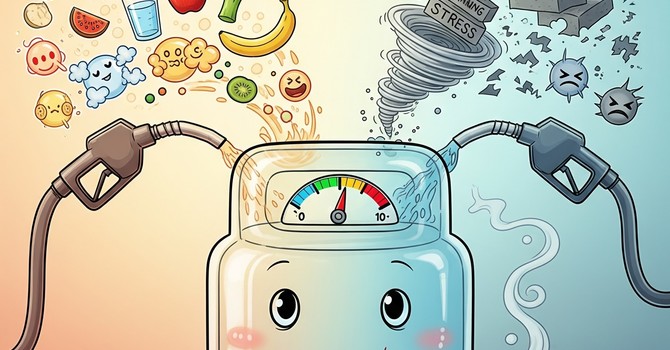.jpg)
Burnout has become a common issue in today's fast-paced world, affecting countless individuals across various professions.
The constant demands of work and life can take a toll on our physical and mental well-being, leading to stress, exhaustion, and even burnout.
Understanding Burnout and Stress
Before we discuss strategies, it's crucial to understand the concepts of stress and burnout. We often talk about tiredness, stress, and exhaustion from a physical well-being perspective. Here, I want us to consider burnout as a feeling of emotional, physical, and mental exhaustion caused by prolonged exposure to high-stress levels.
When we think of burnout, I want us to imagine someone experiencing stress (too much on their plate; everything feels hard). They start experiencing extreme fatigue, sleepless nights, physical tension, lack of interest, a decrease in the sense of joy, and a decline in both productivity and job satisfaction—clear signs of burnout.
While we can manage stress, unmanaged chronic stress leads to burnout, where exhaustion, a loss of enthusiasm, and persistent physical symptoms have taken a more severe toll on overall well-being. Chronic stress can manifest in various ways, including headaches, muscle tension, and fatigue, as well as emotional symptoms like anxiety, irritability, and apathy. Identifying and managing stress is the first step in preventing burnout.
Stress Management Tools
Effective stress management is paramount in preventing burnout, as chronic stress is a major precursor to this debilitating condition.
When it comes to interrupting our flight or fight response (aka stress), I like to use a tool called "The Pause Button." The idea here is to practice pausing before we let our bodies start the automatic function of "we are in danger; protect yourself." This tool lets us consciously calm our nervous system and be in the driver's seat.
Imagine when you are starting to feel the stress piling on (like your boss just asked for the 100th thing you need to do "right now," your toddler hasn't slowed down since the moment they woke up and just said "Mama" for what feels like the 623rd time, or you just crossed something off your to-do list only to get a phone call that means you have three more things to do). Now, I want you to imagine a big stop sign.
STOP.
Get your feet on the ground, and take three deep breaths (I know you can roll your eyes while you do it, but I promise it will help).
Did it help?
Try three more breaths, like you are breathing from the bottom of your torso.
Now, there are two other alternatives to breathing; one is getting something cold, like an icepack, and putting it on your neck, or taking a cold glass of water; the other is shaking it out (like imagine a dog getting out of the water) I want you to move your body to release the physical tension you are feeling by the stress. Now, you can use all three, just one, or pick and choose, but each technique uniquely signals to our bodies that we are okay; a tiger is not chasing us despite what our nervous system believes.
Once we feel like we can think again now, we can start to use other tools in our toolbelt to manage our feelings (if you're not sure what those are, reach out. I'd love to build a unique toolbelt of tools with you!)
The Importance of Body Awareness
When it comes to stress, it can be hard to know when we need to take a break, when we feel overwhelmed, or when we have reached our limits. This disconnect is why it is important to start to cultivate a relationship with our bodies that allows us to tap into and understand the physical symptoms that signal burnout is happening. It's easy to keep going, push through, and move on to the next thing, but that doesn't give us time to recuperate. So when we can check in, how am I feeling? Am I treating my body kindly (with water, good posture, fueling foods, etc.)? We can start to notice when we don't feel well and begin to implement our self-care strategies.
Realistic Self-Care
Wellness isn't just about stress management and body awareness; it encompasses a realistic approach to self-care. Imagine being asked to care for a loved one who isn't feeling well. What would you do to make them feel better?
Here's my basic list: I would ensure they have food, water, rest, joy, movement, and something to keep their minds busy.
This is self-care; it's not always glamorous, it's not always what we want to do, and it often has to come with discipline, but it takes care of us (hence the name—self-care). So, as you would care for your loved one, I want to care for yourself by ticking off these boxes.
Preventing burnout is essential for maintaining a high quality of life and achieving your professional goals.
By incorporating stress management techniques, addressing body awareness, and practicing realistic self-care, you can significantly reduce the risk of burnout.
If you want to prevent (or recover from) burnout, let's book a consultation! Together, we can make a plan to build a resilient and healthy lifestyle that allows you to thrive personally and professionally. Your well-being is worth the investment, so don't wait; start your journey to a burnout-free life today.
The content in this blog is for informational purposes only and is not a substitute for professional medical advice, diagnosis, or treatment. Always consult your doctor or a qualified healthcare provider before trying new healthcare protocols.



.png)